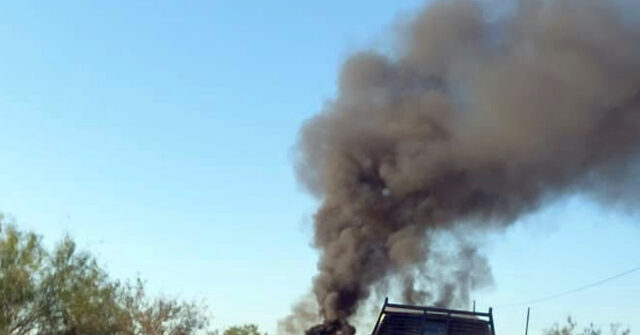The ongoing conflict between rival factions of the Gulf Cartel has escalated into violent turf wars that have impacted numerous cities. Gunmen have increasingly utilized innovative tactics, including the deployment of explosives as improvised landmines and through drones, marking a significant evolution in their operational strategies. One particularly alarming incident occurred just south of Reynosa, Tamaulipas, where members of the Escorpiones cartel faction orchestrated a drone attack on a group of state police officers. The officers, armored and vigilant, were forced to seek refuge in their vehicles to ward off the explosive onslaught. Despite the alarming escalation of violence, assistance from Mexican military forces was glaringly absent, leading to concerns regarding the efficacy and response time of security forces in the region.
In the days preceding the drone assault, the violence had already taken a grave turn with the deaths of three Tamaulipas police officers and injuries to five others resulting from targeted ambushes in the vicinity of Reynosa and San Fernando. These incidents highlight a troubling trend where law enforcement, including members of the Mexican National Guard, appears to be delayed or absent during crucial moments when backup is vital. Despite the surging death toll and a landscape marked by brutality, government officials have downplayed the situation’s severity, insisting that the state remains secure. This dismissive stance stands in stark contrast to the undeniable reality of continuous violence and the increasing audacity of cartel factions operating in the area.
The conflict has nurtured an atmosphere of dread and instability, manifesting in frequent shootouts that disrupt the communities around Reynosa, Rio Bravo, and San Fernando. Each incident adds to the cycle of violence, as gunmen flaunt their power and control through outright brutality, often leaving behind scenes characterized by gore and despair. Recent days have witnessed a significant uptick in violence, with armed confrontations becoming a near-daily occurrence. These incidents not only threaten public safety but also demonstrate the escalating capabilities and willingness of cartel factions to engage in fierce combat with law enforcement.
A notable encounter transpired on a Monday morning in a rural area near Reynosa, where state police managed to kill a gunman and confiscate an armored vehicle. While this isolated incident may appear as a small victory for law enforcement, it underscores a larger narrative of persistently escalating violence and operational complexity faced by Mexican authorities. The combination of advanced weaponry, including armored vehicles utilized by cartel factions, contributes to an increasingly dangerous dynamic on the ground, complicating efforts to establish law and order in the region. The consistent emergence of violent encounters serves as a stark reminder of the challenges that lie ahead for Mexican law enforcement agencies as they combat organized crime.
Journalistic efforts to shed light on the turbulent situation in Tamaulipas are exemplified by the work of prominent reporters like Ildefonso Ortiz and Brandon Darby from Breitbart Texas. Their commitment to covering the intricacies of cartel violence through initiatives like the Cartel Chronicles project plays a critical role in informing the public and drawing attention to the ongoing crisis. By leveraging social media platforms and their reporting, Ortiz and Darby seek to create a more nuanced understanding of the challenges facing border communities, all while emphasizing the urgent need for effective responses from Mexican authorities to curtail the escalation of violence.
Ultimately, the ongoing turf war among rival factions of the Gulf Cartel not only embodies a fight for territorial control but also reflects deeper societal issues at play in Mexico. The apparent ineffectiveness of law enforcement in timely addressing security threats raises fundamental questions about the state’s ability to protect its citizens and enforce the rule of law. As the violence unravels further, it becomes increasingly critical for the Mexican government to address systemic issues within its security forces to restore a semblance of order and safety for those living in the shadow of the escalating cartel conflict. Without meaningful changes to the approach taken against organized crime, the cycle of violence is likely to continue, perpetuating a tragic reality for communities caught in the crossfire.

